The University of Florida News is reporting that a Pacific Ocean barnacle has found its way to the Florida coast. Megabalanus coccopoma is a big, sharp-shelled crustacean that can grow "at least as large as a woman’s palm" (don't ask me where they got that measurement from). Biologists note that the barnacles are expected to be a fouling hazard for boats, but it is so early in the invasion process that the impact of this species is not yet clear. While the species was just discovered in Florida for the first time this summer, records are also known from Georgia, Texas and Louisiana.
Tuesday, October 31, 2006
Monday, October 30, 2006
Trans-Plant
VietNamNet Bridge is reporting that the South American aquatic weed Salvinia molesta may be gaining a foothold in Vietnam. Apparently the floating plant has been used for some time in water gardens in Ho Chi Minh City. Now biologists are concerned that the species will escape from cultivation into local water supplies...as well they should be, as Salvinia molesta is already considered invasive in many other other parts of the world.
Via a forward from the FICMNEW listserver.
Sunday, October 29, 2006
Weekend Blog Blogging
This past week in invasive species blogging:
- The Granite Geek blogs about water milfoil in New Hampshire (a follow up to this post)
- Fish Tales has a story about catching a hitchhiking lamprey.
- The Northern Virginia Reptile Rescue blog posts about the capture of invasive black spiny-tailed iguanas roaming Florida's Gasparilla Island. If you live in Florida and have room in your heart, or if you're a retailer in another state willing to pay the cost of shipping, you can adopt some of the animals and save them from euthanization. Just remember to keep them indoors :-).
- Greenman Tim laments the state of invasive plant politics in Connecticut over at Walking the Berkshires.
Saturday, October 28, 2006
Weekend Photoblogging
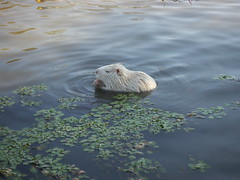
11 novembre 2005 14:05:45
Originally uploaded by *Swift.
An albino nutria! In France! I hope these South American beasties haven't become a boutique item in Paris! :-)
All joking aside, it is unfortunate that the "ragondin" have become established in France.
Thanks to *Swift for posting this excellent photo under a Creative Commons license.
Friday, October 27, 2006
If Pigs Could Die
The Mercury News and others are reporting that the recent E. coli outbreak that contaminated spinach crops in California may have been spread by feral pigs (Sus scrofa). A dead pig recently discovered at a ranch in the Salinas area was found to have the exact strain of E. coli in its gut as the one found in bags of contaminated spinach this past August. Investigators note that there is evidence that the feral pigs have been destroying the fencing that surrounds the ranch land. It remains to be seen whether pigs actually caused the contamination or were just exposed to it themselves, but so far the dead pig is the only genetic match that has been found for the bacteria.
Thursday, October 26, 2006
Kelp Me Kelp You
The Monterey County Herald is reporting that there is a renewed volunteer effort to remove brown kelp (Undaria pinnatifida) from Monterey Bay. The Asian kelp was first seen in the Bay over five years ago, and volunteers were first enlisted to search for and manually remove it back in 2002. It sounds like the current plan is more about keeping the kelp from spreading even further, rather than attempting to reduce its range - the algae is now so abundant that there are fears it will spread from the Bay into the open ocean. This site provides more details of the management efforts.
Wednesday, October 25, 2006
Seek And Ye Shall Find
A recent upgrade to FirstSearch, the U.S. government's search engine, has added an function that lets you search for images across many different federal agency websites. As expected, given the number of agencies dealing with invasive species issues, there are plenty of hits for the vocabularly you regularly see here at the ISW: 2624 hits for "invasive" and 263 for "invader," but unfortunately the search is pulling only the "top" 100 or so from each source and gives you no way of changing that. Out of that, though, there are some gems, like this cartoony one:

The link to the doc above was dead, but I did some sleuthing and found that it belongs to a wonderfully illustrated curriculum guide from SeaGrant Illinois-Indiana, called "The Great Lakes Invasion" (.pdf).
Now if they could just add some Creative Commons licensing like Flickr, I'm sure a lot of people would find these images very useful.
Link via the always brilliant Mr. Sun, who shamelessly stole it from lifehacker and made it much funnier.
Tuesday, October 24, 2006
Mothy
Newswise is reporting about a new research paper documenting the unintended consequences following the introduction of a biological control to the U.S. over a century ago. A parasitic fly (Compsilura concinnata) was one of over 100 organisms brought to the country in an attempt to control the spongy moth (Lymantria dispar). It turned out to be a generalist predator, and is now known to attack more than 180 different butterfly and moth species.
One of its unintended targets was another invasive species, the browntail moth (Euproctis chrysorrhoea). The browntail was considered a serious pest a hundred years ago, but with the introduction of the fly, its populations were being kept in check by the mid-1900s (much better results than with the still problematic spongy moth, but then the browntail moth has enjoyed a coastal resurgence over the past few years.).
For the original article, or at least the abstract of it, you can check out the current issue of the journal Ecology (there is also some supplemental information available here).
Tip o' the virtual hat to budak for posting a link to this story. Sorry to be so far behind this week but Blogger has been flakier than a croissant :-).
Monday, October 23, 2006
Hybrid Drive
The Seattle Post Intelligencer is reporting that at least some of the milfoil (Myriophyllum spp.) taking over waters in northern Idaho is a hybrid between native Northern water milfoil (M. sibiricum) and Eurasian water milfoil (M. spicatum). Not only is the hybrid milfoil tougher than its parents, but scientists say it's also tough to determine whether you've got the hybrid unless you're studying it in the lab.
While the state of Idaho has been pouring money into non-specific herbicides to eradicate water milfoil from bodies of water, there is anecdotal evidence suggesting the hybrid water milfoil has greater resistance to chemical treatment. One environmental group is inquring about a biological control, but it sounds like it is going to be pretty hard to use it yet spare the native plants - the insect they typically use to control European water milfoil is a weevil (Euhrychiopsis lecontei) that was discovered on Northern water milfoil (read this article by Roley and Newman for more info).
Sunday, October 22, 2006
Weekend Photoblogging
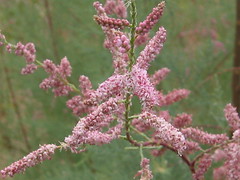
pink tamarisk
Originally uploaded by miheco.
Beautiful, invasive tamarisk in flower in California.
Bonus points to miheco for sharing this photo under a Creative Commons license!
Friday, October 20, 2006
Celebrity Skin
Saw this in Cosmo (don't ask) and confirmed it online - there's a company called The Healing Garden, which makes skin products, that has a new line of organic products that includes Brazilian pepperbush (Schinus terebinthifolius) as an ingredient (see photo below, arrow mine):

This is not meant to imply that the company is contributing to the spread of Brazilian pepperbush, I just thought it was interesting to see an invasive species being used for its herbal properties and perhaps more interestingly, being portrayed aesthetically in the ad campaign. I have no idea where they're getting the pepperbush from or what its purpose is in the lotion (though it seems to have had a glowing, airbrushed effect on Jewel). The Healing Garden donates 50 cents of each purchase to The Nature Conservancy. I wonder if any of that money goes to Schinus removal projects :-).
Thursday, October 19, 2006
Darwinisms
In celebration of the writings of Charles Darwin being collected on the web, searchable and FREE, I bring you Darwin: ISW...
- From his Dec. 1835 visit to New Zealand:
With regard to animals, it is a most remarkable fact, that so large an island, extending over more than 700 miles in latitude, and in many parts ninety broad, with varied stations, a fine climate, and land of all heights, from 14,000 feet downwards, with the exception of a small rat, should not possess one indigenous animal. It is moreover said, that the introduction of the common Norway kind, has annihilated from the northern extremity of the island, the New Zealand species, in the short space of two years. In many places I noticed several sorts of weeds, which, like the rats, I was forced to own as countrymen. A leek, however, which has overrun whole districts, and will be very troublesome, was imported lately by the favour of a French vessel. The common dock is widely disseminated, and will, I am afraid, for ever remain a proof of the rascality of an Englishman, who sold the seeds for those of the tobacco-plant.
- From vol. 779, #46 of the Gardeners' Chronicle and Agricultural Gazette, 1845:
Productiveness of Foreign Seed.—Will the writer of the highly remarkable article on weeds in your last Number have the kindness to state why he supposes that "there is too much reason to believe that foreign seed of an indigenous species is often more prolific than that grown at home?" Is it meant that the plant produced from the foreign seed actually produces more seed, or merely that the introduced stock is more vigorous than the native stock? I have no doubt that so acute an observer has some good reason for his belief. The point seems to me of considerable interest in regard to the great battle for life which is perpetually going on all around us. The great American botanist, Dr. Asa Gray, believes that in the United States there are several plants now naturalised in abundance from imported seed, which are likewise indigenous; and my impression is (but writing from home I cannot refer to his letter to me) that the imported stock prevails over the aboriginal. So again, Dr. Hooker in his admirable Flora of New Zealand has told us that the common Sonchus has spread extensively from imported seed, whilst the same species is likewise an aboriginal; the natives in this instance being able from trifling differences to distinguish the two stocks. Might I further ask whether it is now some years since the seed of Sinapis nigra was accidentally introduced on the farm described; and if so, whether the common Charlock still remains in lessened numbers owing to the presence of the invader, and without, as far as known, fresh seed of the invading S. nigra having been introduced?— whether, in short, it was a fair fight between the two species, ending in the victory of the Black Mustard? Would it be trespassing too much on the kindness of the writer of the article to ask whether he knows of any other analogous cases of a weed introduced from other land beating out, to a greater or lesser extent, a weed previously common in any particular field or farm? C. Darwin, Down, Bromley, Kent.
- From St. Helena, 1836:
It is said, that in 1709 there were quantities of dead wood in Sandy Bay: this place is now so utterly desert, that nothing but so well-attested an account could make me believe that trees had ever existed there. The fact, that the goats and hogs destroyed all the young trees as they sprung up, and that in the course of time the old ones, which were safe from their attacks, perished from age, seems clearly made out. Goats were introduced in the year 1502; eighty-six years afterwards, in the time of Cavendish, it is known they were exceedingly numerous. More than a century afterwards, in 1731, when the evil was completed and found irretrievable, an order was issued that all stray animals should be destroyed.
Number of times Darwin actually uses the word "invasive": none. But he got it, he definitely got it.
Wednesday, October 18, 2006
Ballast of the Broken Seas
If you're new to the whole ballast water controversy, the Christian Science Monitor just posted a good summary of it on their website. It will give you the background knowledge you need about the environmental concerns of "no ballast on board" ships and get you up to date on the state-level legislation that's slowly being put in place to compensate for a lack of regularion at the federal level.
Bonus points to the CSM for getting a great quote from marine invasives expert James Carlton:
"Considering that there are over 30,000 ships at sea this morning," writes James Carlton, director of the Williams College-Mystic Seaport Maritime Studies Program, in an e-mail, "the total number of organisms and species in this global 'bioflow' on the morning your readers read your piece could be staggering - billions of individuals, and thousands of species."
Tuesday, October 17, 2006
Second Nature
Walking the Berkshires had an interesting post last week about that little phrase that keeps popping up in invasive species literature, and sounds something like "second greatest threat to biodiversity after habitat loss." Since I posted a lengthy comment over there, I'm just going to point ISW readers to the whole blog entry, insteading of reposting it here. Go on, go read it!
Monday, October 16, 2006
Dead Ringers
The Orlando Sentinel is reporting that biologists have found a larger version of the channeled apple snail (Pomacea canaliculata) sliming its way around Florida. The island channeled apple snail is such a close relative that it is unclear how to morphologically distinguish the two - I'm not even clear about whether they are separate species or subspecies (This report from 2005 indicates that the confusion has been a long time in the making). Surprisingly, DNA testing suggests that many of the snails previously identified as channeled apple snails are in fact the larger, island taxon. Scientists have pledged to continue to study the giant aquatic snails in hopes of learning enough about their habits and biology to be able to control their spread.
Sunday, October 15, 2006
Weekend Blog Blogging
This past week in invasive species blogging:
- Tim over at Walking the Berkshires posts about the recent grants awarded by the USDA for invasive species research, and notes that the total amount of funding is paltry at best.
- Rigor Vitae's got a post about weevils, including some that are pests and some that are used as biological controls. Let me know if you can get through the whole post without getting distracted by the pretty pictures :-).
- The Migrant Worker blog has a very interesting post about the sensationalization of the Asian swamp eel invasion (they're not even eels, by the way).
- bootstrap analysis has a summary of interesting papers and posters from the recent North American Ornithological Conference, including a whole batch of invasive species-related topics (scroll down).
- A little back and forth between bloggers that I missed last week: Garden Rant posted a blurb (a bit of a rant actually :-)) about the role of chemical companies on the U.S. National Invasive Species Council (scroll down). John Peter Thompson, who is a member of the U.S. Invasive Species Advisory Committee (that works with the NISC) and also a blogger, caught the post and posted this reply on his own blog, Invasive Notes*. Later, Garden Rant posted an update and then an interview with John. Good stuff!
Weekend Photoblogging
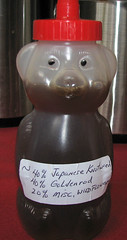
Answer: Knotweed Honey!
Originally uploaded by urtica.
Say what bad things you will about Japanese knotweed...just don't say it to the beekeepers :-).
Thursday, October 12, 2006
How Dry I'm Not
Just got an interesting email alert:
AZ-WEED NOTES: 9 Oct. 2006; Phoenix, AZ
ARIZONA KUDZU DISCOVERY
According to USDA’s Plants database the closest Kudzu populations to Arizona are in eastern Texas.
However, Huachuca City residents say that a strange, sprawling, densely-leaved vine that is smothering a desert broom shrub by their Lions Club building has been around at least 5 years.
During the last week of September, David Madison (Arizona Dept. of Agriculture) collected a sample of the Cochise county plant that eventually ended up at the Maricopa County U-of-AZ Cooperative Extension office on the desk of Dr. Ed Northam, Invasive Plants Program Manager.
Kudzu produces flowers in late summer in other states, so that diagnostic trait was not present on samples collected during the following several days.
In other words, stems, leaves, roots and on site photographs were needed to compile enough vegetative characteristics to determine that Arizona’s first Kudzu (Pueraria) population is thriving in a mountainous semidesert region at an elevation of 4300 feet.
A second opinion was requested from Dr. Kelly Steele (ASU plant taxonomist), and she agreed with the initial diagnosis.
Since Kudzu has demonstrated that its roots can survive winter conditions as far north as Massachusetts, Illinois, Oregon and Washington, it is not surprising that Arizona has areas above 4000 feet elevation that will support Kudzu growth, especially when summer monsoon conditions are wetter than usual.
If you are in Arizona this fall and notice a large woody vine with 3-leaflet compound leaves (leaf length ranges from 4 to 10 inches including a hairy petiole), collect a sample and send it to the Maricopa Cooperative Extension Office.
Kudzu plants that have been growing all summer will have above ground runners that are several feet long; also check to see if an extensive lateral root system is present.
There are photos here; Picture 2 has got a good shot of the infestation.
In The Pink

Live blogging from the Japanese Knotweed Symposium at Cornell University...perhaps the height of geekiness for me this year.
There was a good talk this morning from Christopher Militscher, an EPA guy in Raleigh, North Carolina - yup, they've got knotweed too, and sometimes it's pink. Sounds like the pink-flowered variety (photo above) is starting to show up more frequently in the wild, but so far only in the Southeast U.S. If you've seen it, let me know - there's some biologists I know that are itching for samples :-).
Triple bonus points to ISW reader Allan I. for making the drive here, all the way from Boston!
Tuesday, October 10, 2006
Knotweedy
Off to the Japanese Knotweed Symposium in New York for the next few days...one of the talks I'll be giving is about the Life on the Japanese Knotweed project I started over at Flickr. The best thing about the project is that all of our raw data is publicly accessible. So have a look through the photo pool, head straight to the preliminary results if you're interested, or even download the draft of our raw data.
Monday, October 09, 2006
Kvetch and Release
The New York Times had an interesting article about invasive fish in their "Other Sports" section this past weekend. It discusses several different species introduced in the U.S. and how state and federal agencies are trying to cope with their spread. Particularly intriguing was the section about the releasing of non-native fish into the wild by people observing religious rituals or attempting to establish wild populations for food...and by "people" the reporter means "foreigners." In fact, the article notes that federal wildlife officials see this as a "growing problem."
But then in the very next paragraph:
“There’s a lot of anecdotal information that this goes on,” said Greg Conover, the chairman of the Asian Carp Workgroup for the United States Fish and Wildlife Service. “There’s an effort to reach consumers with brochures in Chinese and other languages, but the cultural barriers are there, and more outreach is needed if we are to change behavior.”
Hmm...anecdotal information like the Times is printing, perhaps? The article goes on to point out several cases of invasive and non-native fish and crustaceans being sold in ethnic markets, but this in itself is certainly not evidence of intentional releases. Educational outreach to teach people about the invasive species they know and eat is not in itself a bad thing, as long as the target audience doesn't feel it's being stereotyped. For a good example of an educational seafood pamphlet, check out MIT Sea Grant's product - they did a nice job with the English version of their seafood pamphlet (and probably with the other languages, but I can't read any of them - can you?).
Sunday, October 08, 2006
Weekend Photoblogging
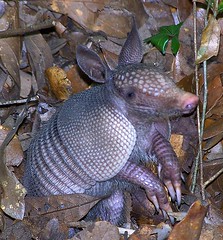
100_4712
Originally uploaded by wildflorida.
Check out that protective armor! The nine banded armadillo (Dasypus novemcinctus), native to Mexico, is said to have migrated naturally into Texas over the last century and a half. It is likely some populations in that state and New Mexico were also intentionally introduced. While this species is now the state mammal of Texas, in Florida, where this photo was taken, the species is considered invasive. The Florida introductions are most frequently attributed to escaped and released individuals.
Thanks to wildflorida for allowing me to share this great photo with you.
Friday, October 06, 2006
Brown Is The New Black
Yahoo! News is reporting that the brown widow spider (Latrodectus geometricus) has become established in the state of Mississippi. As the "widow" in its name suggests, it is poisonous, though it tends to be less aggressive than its cousin, the black widow. While the brown widow is considered non-native in the U.S., and is cited as having been introduced via Florida, it is considered as having a world-wide range in the tropics. Over the past several years, it has been increasing its range from coastal Florida into Mississippi, Alabama and even Texas. No one is quite sure what is driving this range expansion, but it is thought that the spiders use cars, trucks and other vehicles to move around. (Ooo, "driving" - nice unintentional pun!)
Thanks to biosparite for sending in a link to the story. Bonus points to the AP for putting the scientific name of the spider in the article (and in the top paragraph too!).
Thursday, October 05, 2006
We Have A Winner!
Congratulations to Greenman Tim, winner of the "Your Punny Title Here 3" contest. His title, "Seedy Soldiers," will adorn the top of that blog post for all eternity, eternity being determined by the life of this blog.
Greenman will be going home with an ISW prize pack that includes a "Pests in your lake" invasive aquatic plant decal, two Vermont State Park passes, and some other unexpected goodies. Be sure to checkout his blog, Walking the Berkshires, for some great writing about natural history and conservation science.
Stay tuned for a new Punny Title contest coming later this month.
Wednesday, October 04, 2006
VermiAgriculture
Worms as gardeners...who would've thought it? Ohio State University Extension has issued a press release describing the odd behavior of the non-native nightcrawlers (Lumbricus terrestris) in their state. The earthworms have apparently been gathering seed from giant ragweed (Ambrosia trifida) and carrying it back to their burrows. While large ragweed is not the only seed the earthworms like to grab, it seems to be the most popular, a fact made all the more interesting when you consider that giant ragweed is a native plant. What makes the seeds so popular among the nightcrawler crowd? Scientists aren't yet sure, but they have hypothesized that the earthworms might be using the seeds to strengthen their burrows, or as a future food source once the seeds start to decay. Either way, the resulting effect is similar to the squirrel-acorn relationship: many of these buried seeds go on to germinate, and it is thought that the activities of the earthworms have greatly contributed to the spread of giant ragweed.
Tuesday, October 03, 2006
Four Long Years
It's been four years since the northern snakehead (Channa argus) hit the big time in the Potomac River, and while the fish have continued to spread successfully, scientists have not as of yet found any adverse affects caused by the invasion. Could it be that the species will find a niche in the ecosystem with nary a negative impact? It's more likely that it will just be many years before the full effects on the Potomac are known. Either way, there's no realistic chance of eradicating the fish, so they're here to stay. National Geographic News has the full story.
Monday, October 02, 2006
Let Zem Eet Fishcakes!
Boy, people are always trying to think of new ways to use up all the extra carp we've got in the U.S. The St. Louis Post-Dispatch is reporting what may be the oddest use yet: fishcakes...for zoo animals. A University of Missouri scientist is currently testing a variety of combinations of carp, gelatin and vitamins to find the perfect combo that is both palatable and holds together when thrown at a hungry animal. The St. Louis Zoo uses 60 tons of fish every year to feed its sea lions, penguins and other animals, so chances are that cheap invasive carp could provide a significant economic benefit.
Sunday, October 01, 2006
Weekend Blog Blogging
Slim pickins this past week in invasive species blogging:
- I was going to post about this article discussing the problems of using invasive species as biofuel, but then I found that BirderBlog had already done so, and did a much more thorough job than I would have.
- The Little Garden blog posts about going native in the garden.
Deadline Looming
Last chance to get your entries in for the "Your Punny Title Here 3" contest - deadline is at midnight EDT tonight.
Weekend Photoblogging
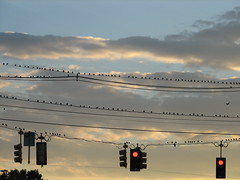
birds on a wire
Originally uploaded by urtica.
But a small portion of the starling flock that hangs out by the Natick Mall (Natick, MA). None of them seemed to mind me taking this photo - at least, they did not leave any "gifts" on my car as I drove underneath :-).
